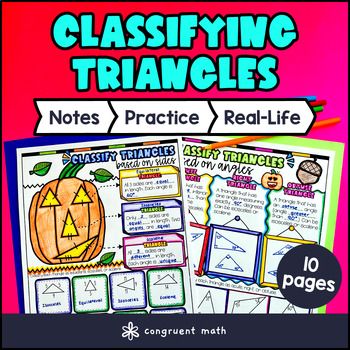Want more ideas and freebies?
Get my free resource library with digital & print activities—plus tips over email.
Join for Free Resources →
$4.25
Ever wondered how to teach classifying triangles by sides and angles in an engaging way to your 5th-grade students? In this lesson plan, students will learn about how to classify triangles by sides (equilateral, isosceles, scalene) as well as classify triangles by angles (acute, obtuse, right). Through artistic, interactive guided notes, check for understanding, practice coloring worksheet, and a maze, students will gain a comprehensive understanding of triangle classification. Students will be given examples of each type of triangles as well as triangles that may fall into multiple category (i.e. an isosceles acute triangle).
The lesson ends with a real-life example that explores how understanding the properties of triangles can be applied in everyday scenarios. Students will read and write about the real-life uses of classifying triangles, connecting their learning to practical situations.

$4.25
After this lesson, students will be able to:
Before this lesson, students should be familiar with:
As a hook, ask students why understanding the different types of triangles might be useful in real life situations. Refer to the last page of the guided notes titled "Real-life application" for ideas on how to link triangle classification to practical scenarios.
Use the first page of the guided notes to introduce the concept of classifying triangles by their sides (equilateral, isosceles, scalene triangles). Walk through the definitions of each type of triangle, emphasizing the key characteristics that differentiate them. Refer to the FAQ below for a walk-through on this topic, as well as ideas on how to respond to common student questions.
Proceed to use the second page of the guided notes to introduce classifying triangles by their angles (acute, obtuse, right triangles). Explain the definitions of each type of triangle based on angle measurements, highlighting how to identify them visually. Refer to the FAQ below for guidance on teaching this section effectively and addressing any student inquiries.
Based on the students' responses during the introduction and initial explanation, reteach any concepts that students may need additional help understanding. If there is a wide range of proficiency levels in the class, consider pulling out students for reteaching while more advanced students begin working on the upcoming practice exercises.
Have students practice classifying triangles by sides and angles using the practice worksheet included in the resource. Students can start with the maze activity (pg. 3 of guided notes) to practice classifying triangles to escape the maze. Walk around to answer student questions.
Then, fast finishers can start the color by code activity (pg. 4 of guided notes) for extra practice. You can assign it as homework for the remainder of the class.
Using the last page of the guided notes, bring the class back together, and introduce the concept of using triangles in architecture and construction. Triangles are essential in constructing stable and sturdy structures like bridges, buildings, and even roller coasters. Discuss with students how architects and engineers use their knowledge of different types of triangles to design and build safe and reliable structures. Students will read about the real life applications and reflect on a short prompt as well as complete a self assessment on their confidence level on this math topic.
Refer to the FAQ for more ideas on how to teach it!
If you're looking for digital practice for Classifying Triangles by Angles & Sides, try my Pixel Art activities in Google Sheets. Every answer is automatically checked, and correct answers unlock parts of a mystery picture. It’s incredibly fun and a powerful tool for differentiation.
Here is an activity to explore:
A fun, no-prep way to practice Classifying Triangles by Angles & Sides is Doodle Math — they’re a fresh take on color by number or color by code. It includes multiple levels of practice, perfect for a review day or sub plan.
Here are 1 activity to try:
There are three main types of triangles based on their angles:
Triangles can be classified into three categories based on their sides:
The sum of the three angles in any triangle is always 180 degrees.
An equilateral triangle has three equal sides and three equal angles, each measuring 60 degrees.
A triangle is classified as obtuse if one of its angles measures more than 90 degrees.
Isosceles triangles have two sides of equal length and two equal angles, while scalene triangles have all sides of different lengths and no equal angles.
No, a triangle cannot be both acute and equilateral because an equilateral triangle has all angles measuring 60 degrees, which are acute angles.
A right triangle has one angle that measures exactly 90 degrees.
Get my free resource library with digital & print activities—plus tips over email.
Join for Free Resources →